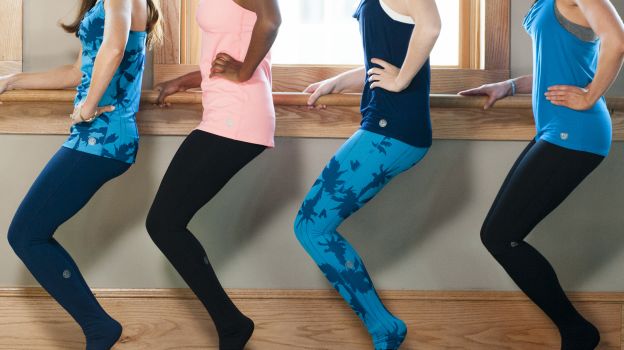Barre classes improve balance, coordination and muscular endurance, but they are likely to lack an aerobic component. MUST CREDIT: Pure Barre.In this era of CrossFitters, SoulCyclists and yogis, as well as barre, Zumba and Insanity devotees, people often focus on one - and only one - fitness format.
So what exactly are you getting if you are doing only that one particular routine - say, yoga - and what are you missing out on?
We asked a couple of fitness experts and a local endurance athlete to guide us through the field of popular fitness routines - their upsides, their limitations and what you might add to them to round out your program.
Barre
What you get: Using a ballet barre for balance, you typically will perform a combination of small ballet-inspired movements and static poses that provide isometric training. "A barre class offers a nice combination of balance and coordination," says Anthony Wall, director of professional education for the American Council on Exercise. "It works postural muscles, which improves stability." Postural muscles include both the front body (such as abdominal muscles) and, more important, the back muscles that help lift the body up. Barre also improves muscular endurance: the ability of muscles to sustain force against resistance over time (think of the repetitive movement and holds typical of ballet).
What to add: A barre class is unlikely to improve external-load-bearing strength (as free weights do) or aerobic fitness (as from power walking or running). "So you might add kayaking or hiking for that aerobic component," Wall says.
And maybe some weights: "In order to improve bone density, you need some extra load and impact," says Linda Haupt, regional group fitness director for Gold's Gym on the East Coast.
Insanity
What you get: A high-intensity interval body-weight class such as Insanity or P90X (both branded products) usually lasts up to 30 minutes and features drills that drive the heart rate into an anaerobic zone - more than 80 percent of maximum heart rate. Gold's gym uses a version called Grit, developed by the Les Mills brand.
"It's very efficient and includes agility, speed, dynamic jumping and strength - it's full-body," Haupt says. The post-exercise fat burn is higher and longer with this type of training than after aerobic exercise, she says.
Wall adds that body-weight exercises such as lunges and push-ups, whether done in a high-intensity format or not, are great functional exercises. "When you use the body as a tool, it helps create better control and body awareness."
What to add: You're not getting much aerobic work with high-intensity intervals, so adding running, cycling or swimming would be a good complement, Wall says. Another way to round out the routine would be to add some external load bearing, such as free weights.
Haupt says she would also recommend adding some flexibility - maybe a yoga class to stretch out the body.
CrossFit
What you get: CrossFit is a brand that features high-intensity intervals but, unlike Insanity, also uses external loading. "With the high intensity, you are improving your cardiovascular system," Wall says, and the external load bearing improves strength. Other benefits include weight loss and, maybe most important, the social aspect - the feeling of being part of something larger.
"You could do the same type of exercises elsewhere, but CrossFit offers a community, a sense of belonging that we all want," Wall says.
What to add: Haupt suggests incorporating some mobility and stability work, maybe through yoga.
Wall recommends adding an aerobic component. "Even top athletes have to work in that low-intensity arena to help them recover better," he says.
Indoor cycling
What you get: Indoor cycling can mean long-distance, steady-state drills, Wall says, which can be an excellent way to build aerobic capacity. But the most popular format focuses on short, high-intensity intervals - in other words, anaerobic work, he says. Like CrossFit, it helps improve the cardiovascular system and encourages weight loss. It also strengthens the legs.
What to add: Wall suggests adding something like boxing to strengthen the upper body and core as well as to work on rotating the body to complement the static body position on a bike.
Haupt agrees and adds that lateral movement (side to side) is crucial for injury prevention for runners and cyclists alike. Stretching - in particular, hip flexors, gluteus and hamstrings - can also help not only with recovery and injury prevention but also, ultimately, with performance.
Long-time endurance athlete and Washington resident Carolyn Abramczyk, 38, can attest to this. She had been doing long-distance-running races and triathlons for years, with all the training focused on endurance.
"I didn't see any improvement in my running until I started doing yoga," Abramczyk says. "I felt it really improved my core strength."
She even had a personal record in a half-marathon with a sub-1:45 finish in 2014. She credits yoga. "I felt taller, stronger during the whole race."
Now she does yoga at least three times a week in addition to cycling and running.
Yoga
What you get: Yoga can mean a lot of things, Haupt says, and the benefits will depend on the style of yoga you are practicing. With Ashtanga, a powerful, fast-moving style of yoga, you might get your heart rate up, and with something like Iyengar, where you hold poses for a long time, you might work more muscle endurance, she says. But generally speaking, yoga focuses on balance, flexibility, breathing, relaxation and meditation.
What to add: A cardio component - whether aerobic or anaerobic - to improve the cardiovascular system, Haupt says. Also, some external load bearing would be beneficial to create more strength and improve bone density.
Zumba
What you get: Zumba is a program that incorporates dance and aerobic fitness. Like CrossFit, Zumba has a social component that encourages participants to keep coming back, Wall says. And like any dance-based routine, it improves coordination and balance.
Haupt adds that with all the hip and lateral moves, it also helps strengthen the core and pelvic area.
What to add: Haupt suggests adding a strength component, particularly for the upper body, and additional stretching for the lower body, including hips. Yoga or Pilates could fit the bill.
Wall adds that total-body conditioning such as high-intensity intervals can be a good complement to the mostly aerobic dance format.
The takeaway
So there it is. The good, the bad and the ugly of your favorite fitness routine. In the end, you want to mix it up for a host of reasons, including injury prevention, improved performance and motivation as well as better recovery, according to our experts. Variety is the spice of your fitness life.
Boston is a fitness trainer and freelance writer. She can be found at gabriellaboston.com.(c) 2016, The Washington Post







